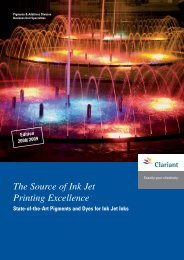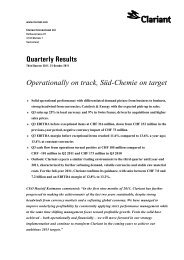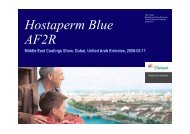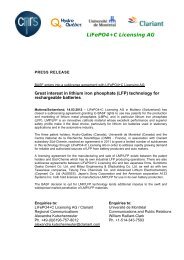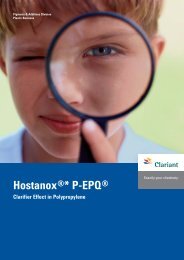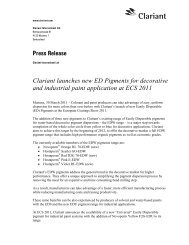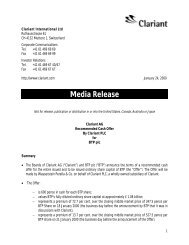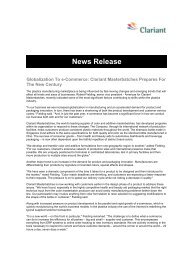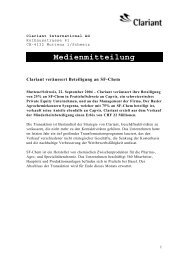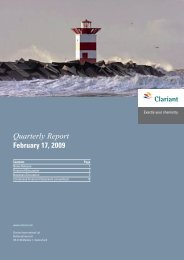Paints and Coatings Auxiliaries for the coating of surfaces - Clariant
Paints and Coatings Auxiliaries for the coating of surfaces - Clariant
Paints and Coatings Auxiliaries for the coating of surfaces - Clariant
You also want an ePaper? Increase the reach of your titles
YUMPU automatically turns print PDFs into web optimized ePapers that Google loves.
Pigments & Additives Division<br />
Coating Business<br />
<strong>Paints</strong> <strong>and</strong> <strong>Coatings</strong><br />
<strong>Auxiliaries</strong> <strong>for</strong> <strong>the</strong> <strong>coating</strong> <strong>of</strong> <strong>surfaces</strong> –<br />
Licowax ® <strong>and</strong> Ceridust ®<br />
Exactly your chemistry.
<strong>Paints</strong> <strong>and</strong> <strong>Coatings</strong><br />
Contents<br />
Function <strong>of</strong> waxes 4<br />
Product range 8<br />
Properties 10<br />
Test methods 14<br />
Application 14<br />
General in<strong>for</strong>mation on<br />
<strong>the</strong> processing <strong>of</strong> waxes 18<br />
Ceridust <strong>and</strong><br />
water-based <strong>Coatings</strong> 21<br />
UV reactive waxes 22<br />
Examples <strong>of</strong> <strong>for</strong>mulations<br />
<strong>for</strong> special applications 23<br />
Safety data 28<br />
Transport <strong>and</strong> storage 30<br />
Suppliers 31<br />
2<br />
> <strong>Auxiliaries</strong> <strong>for</strong> <strong>the</strong> <strong>coating</strong> <strong>of</strong> <strong>surfaces</strong><br />
> Licowax <strong>and</strong> Ceridust
Function <strong>of</strong> waxes<br />
Waxes are incorporated in paints<br />
<strong>and</strong> <strong>coating</strong>s to achieve or improve<br />
<strong>the</strong> following properties:<br />
Ester waxes based on crude montan wax<br />
4<br />
Licowax KLE<br />
Polyethylene waxes<br />
Licowax PE 520<br />
Licowax PED 521<br />
Licowax PED 522<br />
Ceridust<br />
Ceridust 3620<br />
Ceridust 9615 A<br />
Ceridust 6721<br />
Ceridust 3715<br />
Ceridust 2440<br />
Ceridust 3719<br />
Ceridust 9610 F<br />
Ceridust 9630 F<br />
Ceridust 3920 F<br />
TP Ceridust 3921 F<br />
Ceridust 9325 F<br />
Matting Improving<br />
mar resistance<br />
Outst<strong>and</strong>ingly effective<br />
Enhancing<br />
antiblocking<br />
behaviour<br />
Improving<br />
s<strong>and</strong>ability<br />
Improving<br />
slip<br />
Good effectiveness in most <strong>for</strong>mulations<br />
Improving<br />
h<strong>and</strong>le
Improving Steering Preventing Water Preventing Orientation Texturing<br />
smoothness rheological pigment repellency metal agent<br />
properties settling marking <strong>for</strong> effect<br />
pigments<br />
5
6<br />
Ceridust<br />
TP Ceridust 9322 F<br />
Ceridust 3910<br />
Ceridust 5551<br />
TP Ceridust 5091<br />
TP Ceridust 5851 R<br />
Ceridust 9202 F<br />
Ceridust 9205 F<br />
TP Ceridust 6050 M<br />
Waxes based on o<strong>the</strong>r raw materials<br />
Licowax C micropowder<br />
Licowax 371 FP<br />
Licowax R 21<br />
Matting Improving<br />
mar resistance<br />
Enhancing<br />
antiblocking<br />
behaviour<br />
Improving<br />
s<strong>and</strong>ability<br />
Improving<br />
slip<br />
Outst<strong>and</strong>ingly effective Good effectiveness in most <strong>for</strong>mulations<br />
Improving<br />
h<strong>and</strong>le
Improving Steering Preventing Water Preventing Orientation Texturing<br />
smoothness rheological pigment repellency metal agent<br />
properties settling marking <strong>for</strong> effect<br />
pigments<br />
7
Product range<br />
Waxes <strong>and</strong> wax micropowders<br />
based on raw montan wax<br />
Licowax KLE is an ester wax which<br />
already contains <strong>the</strong> optimum amount<br />
<strong>of</strong> emulsifier.<br />
Ceridust 5551 is a micronized ester<br />
wax. Due to its polar character it<br />
is best suited <strong>for</strong> use in aqueous<br />
systems.<br />
Waxes <strong>and</strong> wax micropowders<br />
based on polyethylene wax<br />
Licowax PE 520 is a colorless, odourless,<br />
hard, partially branched-chain<br />
polyethylene wax <strong>of</strong> low density.<br />
Because <strong>of</strong> its molecular structure<br />
Licowax PE 520 has a pronounced<br />
matting effect on paint. It is readily<br />
dispersible in hot solvent <strong>and</strong> produces<br />
fine dispersions with good resistance<br />
to settling.<br />
8<br />
Licowax PED 521 <strong>and</strong> Licowax PED<br />
522 are partially branched-chain<br />
polar polyethylene waxes.<br />
The Ceridust grades are micropowders<br />
produced by a special process.<br />
Ceridust 3620 is a linear, hard polyethylene<br />
wax. Ceridust 9615 A is a<br />
modified linear polyethylene wax.<br />
Ceridust 6721 is a new br<strong>and</strong> <strong>of</strong> a<br />
PP blend <strong>of</strong>fering good matting<br />
<strong>and</strong> outst<strong>and</strong>ing s<strong>of</strong>t-feel effect.<br />
Ceridust 3715 <strong>and</strong> 3719 are noted <strong>for</strong><br />
<strong>the</strong>ir excellent wettability by water or<br />
o<strong>the</strong>r polar solvents. Ceridust 9610 F,<br />
Ceridust 9630 F, Ceridust 9325 F <strong>and</strong><br />
TP Ceridust 9322 F are hard polyethylene<br />
waxes <strong>of</strong> linear structure whose<br />
effect is optimized by polytetrafluoroethylene<br />
(PTFE). They are noted <strong>for</strong><br />
excellent slip.<br />
Ceridust 3920 F <strong>and</strong> TP Ceridust 3921 F<br />
are PTFE modified polyethylene waxes<br />
with a very low average particle size<br />
diameter <strong>of</strong> approx. 6.0 µm. There<strong>for</strong>e<br />
<strong>the</strong>y are especially suitable <strong>for</strong> improving<br />
<strong>the</strong> surface lubricity <strong>and</strong> slip<br />
properties in thin film applications.<br />
The Ceridust grades can be finely<br />
dispersed in paints <strong>of</strong> different systems<br />
simply <strong>and</strong> with little mechanical<br />
energy.
Waxes <strong>and</strong> wax micropowders<br />
based on o<strong>the</strong>r raw materials<br />
Licowax C micropowder is a hard<br />
highmelting-point amide wax that can<br />
be easily ground <strong>and</strong> dispersed owing<br />
to its brittleness.<br />
Ceridust 3910 is an especially finegrain<br />
micropowder based on amide<br />
wax; it can be processed with ease<br />
due to its small particle size. Both<br />
wax micropowders exhibit slip which<br />
is advantageous in de<strong>for</strong>mation <strong>and</strong><br />
s<strong>and</strong>ing work.<br />
The Ceridust grades 9202 F <strong>and</strong><br />
9205 F are a low molecular weight<br />
PTFE characterized by antisticking<br />
properties <strong>and</strong> a related surface<br />
effect.<br />
Licowax 371 FP is a flexible polymer<br />
with waxlike properties <strong>and</strong> has<br />
proved effective as an anti-settling<br />
agent <strong>for</strong> pearl-gloss pigments <strong>for</strong><br />
example.<br />
Licowax R 21 is a saponified hydrocarbon<br />
wax which <strong>for</strong>ms particularly<br />
small particle size <strong>and</strong> stable<br />
dispersions in organic solvents.<br />
9
Properties 1)<br />
Ester waxes based<br />
on crude montan wax<br />
Licowax KLE – – 85<br />
Polyethylene Waxes<br />
Licowax PE 520 – – 120<br />
Licowax PED 521 – – 106<br />
Licowax PED 522 – – 105<br />
Ceridust<br />
Ceridust 3620 8.5 13.0 125<br />
Ceridust 9615 A 6.5 12.0 140<br />
Ceridust 6721 7.0 13.0 154<br />
Ceridust 3715 8.5 14.0 125<br />
Ceridust 2440 8.5 13.0 116<br />
Ceridust 3719 13.0 22.0 116<br />
Ceridust 9610 F 8.5 15.0 125<br />
Ceridust 9630 F 8.5 15.0 130 *<br />
Ceridust 3920 F 6.0 10.0 125<br />
TP Ceridust 3921 F 6.0 10.0 125<br />
Ceridust 9325 F 8.5 15.0 125<br />
The delivery specifications are<br />
given in <strong>the</strong> relevant data sheets.<br />
10<br />
Particle size 2), Average analytical values %<br />
50 % value µm 90 % value µm<br />
d 50<br />
1) = The DGF st<strong>and</strong>ard methods can be obtained<br />
from <strong>the</strong> Wissenschaftliche Verlagsgesellschaft<br />
mbH, Birkenwaldstrasse 44, D-70191<br />
Stuttgart-N. Slight deviations may occur<br />
when testing to DIN or ASTM st<strong>and</strong>ards.<br />
2) = Laser diffraction method<br />
d 90<br />
* = S<strong>of</strong>tening point<br />
Drop point<br />
°C
Acid Acid value value Saponification Saponification value value Density Density Color Color Form Form supplied supplied<br />
mg mg KOH/g KOH/g mg mg KOH/g KOH/g at at 23 23 °C °C<br />
g/cm 3 g/cm 3<br />
30 105 1.01 yellowish flakes<br />
0 0 0.93 white powder, granules, grain 3)<br />
17 – 0.95 almost white flakes<br />
25 – 0.96 almost white flakes<br />
0 – 0.97 white micronized powder<br />
3 – 0.99 white micronized powder<br />
4 – 0.95 white micronized powder<br />
4 – 0.97 white micronized powder<br />
4 – 0.95 white micronized powder<br />
18 – 0.98 white micronized powder<br />
0 – 1.00 white micronized powder<br />
3 – 1.10 white micronized powder<br />
≤ 1 – 1.00 white micronized powder<br />
0 – 1.04 white micronized powder<br />
0 – 1.02 white micronized powder<br />
3) = Fine grain: up to about 2 mm with no<br />
restrictions on <strong>the</strong> fineness content.<br />
11
Ester waxes based<br />
on crude montan wax<br />
TP Ceridust 9322 F 6.0 10.0 125<br />
Ceridust 3910 6.5 12.0 142<br />
Ceridust 5551 8.5 14.0 98<br />
TP Ceridust 5091 9.0 14.0 113<br />
TP Ceridust 5851 R 9.0 15.0 77<br />
Ceridust 9202 F 4.0 8.0 327 **<br />
Ceridust 9205 F 8.0 18.0 326 **<br />
TP Ceridust 6050 M 8.5 14.0 145<br />
Waxes based on<br />
o<strong>the</strong>r raw materials<br />
Licowax C micropowder – < 50.0 142<br />
Licowax 371 FP – – 101<br />
Licowax R 21 – – 106<br />
The delivery specifications are<br />
given in <strong>the</strong> relevant data sheets.<br />
12<br />
Particle size 2), Average analytical values %<br />
50 % value µm 90 % value µm<br />
d 50<br />
d 90<br />
2) = Laser diffraction method * = S<strong>of</strong>tening point<br />
Drop point<br />
°C<br />
** = Melting point, test method:<br />
differential scanning calorimetry
Acid value Saponification value Density Color Form supplied<br />
mg KOH/g mg KOH/g at 23 °C<br />
g/cm 3<br />
0 – 1.02 white micronized powder<br />
6 – 1.00 white micronized powder<br />
15 – 1.00 yellowish micronized powder<br />
10 – 1.02 yellowish micronized powder<br />
16 – 1.02 yellowish micronized powder<br />
0 – 2.20 white micronized powder<br />
0 – 2.20 almost white micronized powder<br />
0 – 0.89 white micronized powder<br />
6 – 1.00 white micropowder<br />
21 – 0.96 almost white flakes<br />
5 – 0.94 white flakes<br />
13
Test methods<br />
Drop point DIN 51 801/2<br />
ASTM D 127<br />
S<strong>of</strong>tening point DIN EN 1427<br />
ASTM E 28 / D 36<br />
Acid value DIN EN ISO 3682<br />
ASTM D 1386<br />
Saponification DIN EN ISO 3681<br />
value ASTM D 1387<br />
Density DIN 53 479<br />
Application<br />
ASTM D 1505<br />
The mode <strong>of</strong> action <strong>of</strong> <strong>the</strong> Licowax<br />
<strong>and</strong> Ceridust grades summarized in<br />
section “Function <strong>of</strong> Waxes” opens<br />
up many uses <strong>for</strong> <strong>the</strong>se products in<br />
<strong>the</strong> paint <strong>and</strong> <strong>coating</strong>s sector.<br />
14<br />
Matting<br />
The so-called matt effect <strong>of</strong> paints <strong>and</strong><br />
o<strong>the</strong>r surface <strong>coating</strong>s is produced by<br />
a large number <strong>of</strong> microscopically<br />
small particles that reflect <strong>the</strong> incident<br />
light diffusely. The particle size is <strong>of</strong><br />
crucial importance. Particles visible to<br />
<strong>the</strong> eye with a diameter <strong>of</strong> >20 µm do<br />
not produce a good matt effect.<br />
The ideal particle size is about 10 µm.<br />
Particles with a diameter
Enhancing antiblocking behaviour<br />
The micronized waxes Ceridust 9615 A,<br />
Ceridust 6721, Ceridust 9610 F <strong>and</strong><br />
Ceridust 9630 F have proved particularly<br />
successful in producing an antiblocking<br />
effect in solvent-containing<br />
paints. Ceridust 9615 A exhibits <strong>the</strong><br />
smallest <strong>and</strong> Ceridust 9630 F <strong>the</strong><br />
greatest effect.<br />
Ceridust 3920 F <strong>and</strong> TP Ceridust 3921 F<br />
are primarily suitable <strong>for</strong> can <strong>and</strong> coil<br />
<strong>coating</strong>s where low COF is required.<br />
A special grade <strong>of</strong> PTFE will impart<br />
superior slip <strong>and</strong> anti-blocking<br />
properties.<br />
Improving s<strong>and</strong>ability<br />
In lacquers based on polyurethane,<br />
in acid-curing lacquers <strong>and</strong> furniture<br />
lacquers based on nitrocellulose, <strong>the</strong><br />
addition <strong>of</strong> Licowax C micropowder<br />
has proved successful in improving <strong>the</strong><br />
s<strong>and</strong>ability <strong>of</strong> primers. So that <strong>the</strong> wax<br />
can function optimally, it should first<br />
be dispersed in a solvent suited to <strong>the</strong><br />
recipe with <strong>the</strong> help <strong>of</strong> a bead mill, <strong>for</strong><br />
example (see page 24).<br />
Influencing <strong>the</strong> rheological properties<br />
Licowax PED 521 <strong>and</strong> Licowax PED 522<br />
have proved highly successful <strong>for</strong><br />
preventing sagging <strong>and</strong> running <strong>of</strong><br />
alkyd resin paints (page 25).<br />
Preventing pigment settling<br />
Even small quantities <strong>of</strong> Ceridust<br />
9615 A – 0.5 % to 1.5 % relative to <strong>the</strong><br />
binder – delay <strong>the</strong> settlement <strong>of</strong> pigments<br />
<strong>and</strong> fillers to <strong>for</strong>m a hard sediment.<br />
Sediments do <strong>for</strong>m after some<br />
time but are easily redispersed. An<br />
even more effective way <strong>of</strong> preventing<br />
settling is to use Licowax PE 520 as<br />
a 10 % dispersion. Preparation <strong>of</strong> <strong>the</strong><br />
dispersion is described under<br />
“Preparation <strong>of</strong> a wax dispersion”<br />
on page 18.<br />
In order to improve <strong>the</strong> settling behaviour<br />
<strong>of</strong> pearl-gloss pigments,<br />
Licowax 371 FP can be used <strong>and</strong> is<br />
added as a 6 % dispersion to <strong>the</strong> paint<br />
system. Preparation <strong>of</strong> this dispersion<br />
is described on page 15 in section<br />
“Licowax 371 FP”.<br />
Making paints water-repellent<br />
Ceridust 9615 A is suitable <strong>for</strong> making<br />
protective wood finishes <strong>and</strong> protective<br />
wood stains water-repellent. 2 %<br />
to 6 % <strong>of</strong> <strong>the</strong> product incorporated<br />
in <strong>the</strong> finished paint give <strong>the</strong> film good<br />
water repellency at <strong>the</strong> initial drying<br />
stage; in addition excellent film<br />
smoothness is achieved (page 25).<br />
Preventing metal markings<br />
No metal markings <strong>of</strong> any kind may<br />
occur when metal tools are used on<br />
coated steel strip (coil-coated metal).<br />
This is achieved by adding Ceridust<br />
9610 F, Ceridust 9630 F, Ceridust<br />
3920 F or TP Ceridust 3921 F.<br />
These Ceridust grades have proved<br />
successful with highly matt coil<br />
<strong>coating</strong>s. Fur<strong>the</strong>rmore, <strong>the</strong> painted<br />
surface should be as insensitive as<br />
possible, so that in everyday domestic<br />
use contact with metallic objects<br />
does not leave any marks (table 1).<br />
Superior surface slip<br />
Ceridust 9325 F <strong>and</strong> TP Ceridust 9322 F<br />
are modified PE wax/PTFE blends that<br />
are primarily suitable <strong>for</strong> giving additional<br />
surface slip. The very low mean<br />
particle size diameter <strong>of</strong> only 6 µm<br />
makes TP Ceridust 9322 F extremely<br />
valuable <strong>for</strong> any thin film application.<br />
15
Table 1<br />
Test results with a paint recommended chiefly <strong>for</strong> painting refrigerators<br />
<strong>and</strong> washing machines.<br />
16<br />
Matting agent<br />
Figure 1:<br />
Settling behaviour <strong>of</strong> matting agents in a nitrocellulose lacquer. Observation period 4 weeks.<br />
* In nitrocellulose lacquer, 20 % predispersed<br />
Incorporation at<br />
3000 rpm in min<br />
Matting agent<br />
content in %<br />
Ceridust 9615 A 1 15 2<br />
2 60 2<br />
Silica 3 15 2<br />
4 60 2<br />
Ceridust 9615 A <strong>and</strong> 5 15 2<br />
Silica 1:1<br />
Ceridust 9615 A* 6 15 2<br />
Paint without wax 5 5 4 4<br />
Paint with wax<br />
Paint stoved 10 min. at 80°C<br />
Metal marking by Brass Copper Gold Aluminium<br />
1 % Ceridust 9610 F 4 4 2 2<br />
2 % Ceridust 9610 F 2 2 1 1<br />
3 % Ceridust 9610 F 2 . . . 3 2 1 1 . . . 2<br />
1 % Ceridust 9630 F 3 . . . 4 3 . . . 4 2 2<br />
2 % Ceridust 9630 F 1 . . . 2 1 . . . 2 1 1<br />
3 % Ceridust 9630 F 2 2 1 . . . 2 1 . . . 2<br />
1 % Ceridust 3920 F 4 4 2 2<br />
2 % Ceridust 3920 F 2 2 1 1<br />
3 % Ceridust 3920 F 2 . . . 3 2 1 1 . . . 2<br />
Assessment:<br />
1 = No metal marking<br />
2 = Trace <strong>of</strong> metal marking<br />
3 = Slight metal marking<br />
4 = Some metal marking<br />
5 = Distinct metal marking<br />
The quantities added are relative<br />
to <strong>the</strong> total <strong>for</strong>mulation.
Paint stoved 10 min at 140°C<br />
Brass Copper Gold Aluminium<br />
5 5 4 4<br />
3 2 2 1<br />
2 2 1 1<br />
2 . . . 3 2 1 1 . . . 2<br />
2 . . . 3 2 2 1<br />
1 . . . 2 1 . . . 2 1 1<br />
2 2 1 . . . 2 1 . . . 2<br />
3 2 2 1<br />
2 2 1 1<br />
2 . . . 3 2 1 1 . . . 2<br />
17
General in<strong>for</strong>mation on<br />
<strong>the</strong> processing <strong>of</strong> waxes<br />
The waxes described here are insoluble<br />
at room temperature in <strong>the</strong> common<br />
paint solvents. They dissolve only at<br />
elevated temperatures in aromatic<br />
<strong>and</strong> a number <strong>of</strong> aliphatic solvents,<br />
mainly nonpolar hydrocarbons. When<br />
<strong>the</strong> wax/solvent mixture cools, <strong>the</strong><br />
wax precipitates with varying degrees<br />
<strong>of</strong> crystallinity <strong>and</strong> remains finely<br />
dispersed in <strong>the</strong> solvent. By altering<br />
<strong>the</strong> type <strong>and</strong> quantity <strong>of</strong> <strong>the</strong> components<br />
<strong>and</strong> <strong>the</strong> dispersion method, it is<br />
possible to vary <strong>the</strong> dispersing operation<br />
considerably so as to achieve<br />
differences in <strong>the</strong> structure <strong>of</strong> <strong>the</strong><br />
particles <strong>and</strong> <strong>the</strong> degree <strong>of</strong> dispersion<br />
<strong>and</strong> thus in <strong>the</strong> consistency <strong>of</strong> <strong>the</strong><br />
dispersion.<br />
Similar fine dispersions can be produced<br />
using Ceridust without hot precipitation.<br />
These micronized powders <strong>of</strong>fer <strong>the</strong><br />
following advantages:<br />
> No heating <strong>of</strong> wax <strong>and</strong><br />
solvent required.<br />
> No solvent vapours arise.<br />
> The risk <strong>of</strong> fire is reduced<br />
to a minimum.<br />
> Necessary dispersing machines are<br />
in operation <strong>for</strong> a short time only,<br />
thus saving time <strong>and</strong> energy.<br />
> Processing is environmentally safe.<br />
18<br />
Additions <strong>of</strong> 1% to 5 % wax, relative to<br />
<strong>the</strong> ready-to-use paint, have proved<br />
successful in practice. Higher additions<br />
are likely to cause impairment <strong>of</strong><br />
<strong>the</strong> paint film in <strong>the</strong> <strong>for</strong>m <strong>of</strong> chalking,<br />
cratering, pinholing <strong>and</strong> deterioration<br />
<strong>of</strong> re<strong>coating</strong> properties <strong>and</strong> intercoat<br />
adhesion.<br />
Licowax PE 520<br />
The Licowax PE 520, which is supplied<br />
in <strong>the</strong> <strong>for</strong>m <strong>of</strong> granules, fine grain <strong>and</strong><br />
powder, cannot be incorporated directly<br />
into paint systems. It is necessary first<br />
to produce fine wax particles by dissolving<br />
<strong>and</strong> precipitating <strong>the</strong> product.<br />
The following methods are suitable:<br />
> Hot precipitation<br />
Heat 2 parts by weight Licowax PE<br />
520 with 18 parts by weight solvent,<br />
mainly composed <strong>of</strong> aromatics, to<br />
about 100 °C; <strong>the</strong> resultant solution<br />
must be clear. Stir this solution into<br />
80 parts by weight cold paint. With<br />
this procedure <strong>the</strong> wax is precipitated<br />
in <strong>the</strong> paint in a very finely<br />
dispersed <strong>for</strong>m <strong>and</strong> has hardly any<br />
tendency to settle.<br />
> Preparation <strong>of</strong> a wax dispersion<br />
An approx. 10 % dispersion in xylene<br />
can be prepared by <strong>the</strong> following<br />
simple method: Heat 10 parts by<br />
weight Licowax PE 520 <strong>and</strong> 30 parts<br />
by weight xylene to about 100 °C,<br />
<strong>the</strong>reby dissolving <strong>the</strong> wax. After<br />
cooling <strong>the</strong> solution to about 96 °C<br />
stir into 60 parts by weight cold<br />
xylene. 1% to 5 % wax in <strong>the</strong> paint<br />
is recommended depending on <strong>the</strong><br />
matt effect required.
Licowax PED 521, Licowax PED 522<br />
Dissolve 20 to 30 parts by weight<br />
Licowax PED 521 or Licowax PED 522<br />
at about 90 °C in 80 to 70 parts by<br />
weight xylene or white spirit. Cool <strong>the</strong><br />
hot solution to room temperature with<br />
slight stirring <strong>and</strong> incorporate in <strong>the</strong><br />
paint (page 25).<br />
Licowax 371 FP<br />
Heat 6 parts by weight Licowax 371 FP<br />
<strong>and</strong> 30 parts by weight xylene to<br />
100 °C <strong>and</strong> cool while stirring to 75 °C.<br />
After reaching this temperature,<br />
<strong>the</strong> solution is diluted with 64 parts by<br />
weight butyl acetate 98/100 % while<br />
stirring <strong>and</strong> cooled to room temperature.<br />
The wax content in <strong>the</strong> finished<br />
paint should be about 1-2 %.<br />
Ceridust 9615 A, Ceridust 6721<br />
The micronized powders can be stirred<br />
directly into <strong>the</strong> paint. A minimum<br />
mixing time <strong>of</strong> 15 minutes is advisable<br />
to ensure satisfactory wetting <strong>of</strong> <strong>the</strong><br />
individual wax particles (page 22).<br />
However, it is expedient first to prepare<br />
a stock paste. It is sufficient to admix<br />
20-30 % Ceridust micropowder with a<br />
suitable solvent <strong>and</strong> to stir <strong>the</strong> batch<br />
<strong>for</strong> about 15 minutes. Very homogeneous<br />
dispersions with good stability to<br />
settling are obtained by <strong>the</strong> additional<br />
use <strong>of</strong> a small amount <strong>of</strong> binder. This<br />
procedure is particularly recommended<br />
when o<strong>the</strong>r paint additives such as<br />
silica are also included in <strong>the</strong> paint<br />
<strong>for</strong>mulation.<br />
19
Ceridust 3910<br />
Ceridust 3910 has very fine particles.<br />
It can be stirred slowly direct into <strong>the</strong><br />
paint system (normally 1 % to 2 %).<br />
The stirring time should be at least<br />
10 minutes. Subsequent thickening <strong>of</strong><br />
such dispersions may occur. In this<br />
case <strong>the</strong> viscosity can be lowered by<br />
stirring again thoroughly.<br />
Licowax C micropowder<br />
Very fine dispersions with a maximum<br />
solids content <strong>of</strong> 15 % <strong>and</strong> an average<br />
particle size <strong>of</strong> about 3.5 µm can be<br />
produced by dispersing Licowax C<br />
micropowder in <strong>the</strong> appropriate<br />
solvent in a bead, s<strong>and</strong> or ball mill.<br />
20<br />
Ceridust 9610 F, Ceridust 9630 F,<br />
Ceridust 3920 F, TP Ceridust 3921 F,<br />
Ceridust 9325 F, TP Ceridust 9322 F<br />
Like all Ceridust grades, <strong>the</strong>se products<br />
can be stirred directly into <strong>the</strong> paint<br />
system. An addition <strong>of</strong> 0.8 to 1.5 % by<br />
weight is sufficient in view <strong>of</strong> <strong>the</strong> high<br />
efficacy <strong>of</strong> <strong>the</strong> different PTFE contents<br />
<strong>of</strong> <strong>the</strong> Ceridust grades 9610 F, 9630 F,<br />
3920 F, 3921 F, 9325 F <strong>and</strong> 9322 F.<br />
The mixing time should be at least 15<br />
minutes to achieve adequate wetting<br />
<strong>of</strong> <strong>the</strong> individual wax particles.<br />
Ceridust 9630 F in particular, with its<br />
higher PTFE content, should be mixed<br />
in <strong>the</strong> <strong>for</strong>m <strong>of</strong> a masterbatch into <strong>the</strong><br />
binder <strong>and</strong> <strong>the</strong>n added to <strong>the</strong> paint. In<br />
a highly mobile paint Ceridust 9630 F<br />
tends to settle because <strong>of</strong> its higher<br />
density.<br />
Ceridust 9202 F, Ceridust 9205 F<br />
These pure PTFE grades can be processed<br />
similarly to Ceridust 9630 F.<br />
Quantity added: 0.3 to 0.8 % by weight.
Ceridust <strong>and</strong> waterbased<br />
<strong>Coatings</strong><br />
Ceridust 3715, Ceridust 2440,<br />
Ceridust 3719 <strong>and</strong> Ceridust 5551<br />
These grades are micronized powders<br />
with improved wetting properties<br />
specially developed <strong>for</strong> water-thinnable<br />
paints <strong>and</strong> aqueous systems. The<br />
following methods are suitable <strong>for</strong><br />
incorporating <strong>the</strong>m in paints <strong>and</strong><br />
surface <strong>coating</strong>s:<br />
Stir direct into <strong>the</strong> paint system;<br />
<strong>the</strong> mixing time should be at least<br />
15 minutes.<br />
In case that co-solvent is used as part<br />
<strong>of</strong> <strong>the</strong> water-based <strong>coating</strong> <strong>for</strong>mulation<br />
<strong>the</strong> dispersion <strong>of</strong> <strong>the</strong> micronized wax<br />
can be improved by preparing a highly<br />
concentrated wax dispersion which<br />
will <strong>the</strong>n be subsequently added to<br />
<strong>the</strong> <strong>for</strong>mulation. This procedure ensures<br />
an adequate wetting <strong>of</strong> <strong>the</strong> wax<br />
particles <strong>and</strong> avoids high shear <strong>for</strong>ces<br />
<strong>for</strong> <strong>the</strong> binder system as <strong>the</strong>se systems<br />
can be shear sensitive. Trials have<br />
proven that solvents like butylglycol,<br />
butyldiglycol, <strong>and</strong> DPM are ideal<br />
<strong>for</strong> <strong>the</strong> dispersing <strong>of</strong> <strong>the</strong> mentioned<br />
micronized waxes. Depending on<br />
<strong>the</strong> solvent <strong>and</strong> type <strong>of</strong> wax concentrations<br />
<strong>of</strong> approx. 40 % are possible<br />
without <strong>the</strong> use <strong>of</strong> any additves.<br />
In <strong>the</strong> case <strong>of</strong> pigmented systems,<br />
Ceridust is processed toge<strong>the</strong>r with<br />
<strong>the</strong> pigments <strong>and</strong> fillers. A stirring<br />
time <strong>of</strong> 15 minutes is generally sufficient<br />
<strong>for</strong> adequate wetting <strong>of</strong> <strong>the</strong> wax<br />
particles.<br />
If <strong>the</strong> dry film thickness <strong>of</strong> <strong>the</strong> <strong>coating</strong>,<br />
especially in can <strong>coating</strong> <strong>and</strong> metal<br />
decoration, is to be < 12 µm, it is advisable<br />
to disperse <strong>the</strong> wax in <strong>the</strong><br />
appropriate binder/solvent mixture by<br />
means <strong>of</strong> a bead mill or similar machine.<br />
20 % to 30 % wax preparations<br />
can be produced.<br />
If wetting is inadequate, it should be<br />
borne in mind that Ceridust 3715, 2440<br />
or 3719 tend to cream in aqueous<br />
systems <strong>and</strong> not to settle as in solventcontaining<br />
systems.<br />
Since many water-thinnable binders<br />
are alkaline or have to be adjusted<br />
with amines to a pH <strong>of</strong> 8 to 9, foaming<br />
<strong>of</strong> varying degrees <strong>of</strong> severity may<br />
occur when Ceridust is stirred in. If<br />
<strong>the</strong> <strong>coating</strong> contains too much foam,<br />
film defects occur when it is applied.<br />
In this case a silicone-free defoamer<br />
has to be added. The quantities to be<br />
added must be determined in preliminary<br />
trials.<br />
21
UV reactive waxes<br />
TP Ceridust 5091, TP Ceridust 5851 R<br />
TP Ceridust 5091 <strong>and</strong> TP Ceridust<br />
5851 R feature an entirely new wax<br />
chemistry by making Montan ester<br />
waxes UV reactive. Thus this newly<br />
designed micronized waxes are<br />
enable to polymerize in any given<br />
UV cured <strong>coating</strong> system. As <strong>the</strong><br />
wax is linked to <strong>the</strong> polymer matrix<br />
<strong>the</strong>re is little to no migration to <strong>the</strong><br />
surface <strong>of</strong> <strong>the</strong> <strong>coating</strong>. The benefits<br />
<strong>of</strong> this new technology are long<br />
lasting improvement <strong>of</strong> scratch <strong>and</strong><br />
mar resistance, slip <strong>and</strong> abrasion<br />
resistance <strong>and</strong> inreased water <strong>and</strong><br />
chemical resistance.<br />
TP Ceridust 5851 R can improve <strong>the</strong><br />
already excellent matting properties<br />
<strong>of</strong> TP Ceridust 5091 due to a unique<br />
blend <strong>of</strong> UV reactive wax <strong>and</strong> a<br />
specialty matting ingredient.<br />
The following test results underpin <strong>the</strong><br />
superior per<strong>for</strong>mance <strong>of</strong> UV reactive<br />
waxes vs. non-reactive st<strong>and</strong>ard<br />
waxes in UV cured systems.<br />
UV curable topcoat with<br />
100% solids content<br />
Guide <strong>for</strong>mulation<br />
Laromer LR 9007 (BASF) 62.0<br />
Laromer LR 8967 (BASF) 21.5<br />
Talkum 10 MOOS 3.0<br />
Syloid 162 C (Grace) 7.0<br />
Wax (<strong>Clariant</strong>) 3.0<br />
Tego Airex (Tego) 0.5<br />
Irgacure 500 (Ciba) 3.0<br />
Parts by weight 100.0<br />
22<br />
100<br />
90<br />
80<br />
70<br />
60<br />
50<br />
40<br />
30<br />
20<br />
10<br />
0<br />
1<br />
0.9<br />
0.8<br />
0.7<br />
0.6<br />
0.5<br />
0.4<br />
0.3<br />
0.2<br />
0.1<br />
0<br />
without wax Ceridust 9615 A Ceridust 6721 TP Ceridust 5091 TP Ceridust 5851 R<br />
Figure 3: Matting <strong>of</strong> UV cured <strong>coating</strong> (60°).<br />
Wet film thickness 12 µm, curing speed 10 m / min (mercury vapor lamp 160 watt),<br />
wax content 4 % on total <strong>for</strong>mulation.<br />
without wax Ceridust 9615 A Ceridust 6721 TP Ceridust 5091 TP Ceridust 5851 R<br />
measurement weight 1.805 kg<br />
Figure 4: Coefficient <strong>of</strong> Friction – UV cured <strong>coating</strong>.<br />
Wet film thickness 12 µm, curing speed 10 m / min (mercury vapor lamp 160 watt),<br />
wax content 4 % on total <strong>for</strong>mulation.<br />
Water-based UV curable <strong>coating</strong>s<br />
On top <strong>of</strong> <strong>the</strong> UV reactive micronized<br />
waxes also non-reactive waxes can be<br />
successfully applied to water-based<br />
UV curable <strong>coating</strong>s. Particularly <strong>the</strong><br />
polar modified micronized waxes like<br />
Ceridust 3715, 2440 <strong>and</strong> 5551 show<br />
excellent effects. These grades feature<br />
an effective matting effect, better<br />
surface slip <strong>and</strong> improved scratch<br />
resistance.<br />
UV curable water-based <strong>coating</strong><br />
Guide <strong>for</strong>mulation<br />
Bayhydrol UV VP LS 2282 60.0<br />
Dehydran 1293 (Cognis) 0.8<br />
Irgacure 500 (Ciba) 0.5<br />
Byk 348 (Byk) 0.5<br />
Wasser 37.3<br />
SchwegoPUR (Schwegmann) 0.9<br />
Parts by weight 100.0
Examples <strong>of</strong> <strong>for</strong>mulations<br />
<strong>for</strong> special applications<br />
Matting<br />
Nitrocellulose lacquers<br />
Nitrocellulose lacquers, whose main<br />
component is cellulose nitrate, are<br />
still used on a wide scale <strong>for</strong> furniture<br />
lacquers. The matting agent used in<br />
<strong>the</strong>se lacquers is almost exclusively<br />
wax. The most important products <strong>for</strong><br />
this purpose are Licowax PE 520,<br />
Ceridust 9615 A <strong>and</strong> Ceridust 6721.<br />
When low-viscosity curtain-<strong>coating</strong><br />
paints are manufactured, it is advisable<br />
to incorporate Licowax PE 520 by hot<br />
precipitation (page 18).<br />
Ceridust 9615 A or Ceridust 6721 are<br />
better suited to paints applied by<br />
spray or brush. It tends to settle out<br />
slightly when left to st<strong>and</strong> <strong>for</strong> some<br />
time but can be readily redispersed<br />
by stirring. To prevent settling out as<br />
far as possible it is advisable to use<br />
5 % <strong>of</strong> a 10 % dispersion with Licowax<br />
PE 520.<br />
Gloss<br />
160<br />
140<br />
120<br />
100<br />
80<br />
60<br />
40<br />
20<br />
0<br />
0.5<br />
Frequently <strong>the</strong> tendency <strong>of</strong> Ceridust<br />
9615 A or Ceridust 6721 to settle is due<br />
to inadequate wetting <strong>of</strong> <strong>the</strong> individual<br />
wax particles. In this case we recommend<br />
that a paint /wax concentrate<br />
should be prepared. The following<br />
procedure is recommended: incorporate<br />
25 to 30 parts by weight Ceridust<br />
in 75 to 70 parts by weight <strong>of</strong> <strong>the</strong> paint<br />
to be matted <strong>and</strong> continue to stir until<br />
a homogeneous paste is obtained.<br />
1.0 2.0<br />
p. Wax<br />
3.0<br />
4.0<br />
without <strong>the</strong> addition Ceridust 9615 A Licowax PE 520<br />
<strong>of</strong> wax 10 % dispersion<br />
Figure 2:<br />
NC lacquer Wet film thickness 60 µm Gloss 60°.<br />
After being allowed to st<strong>and</strong> <strong>for</strong> 10<br />
to 26 hours this paste is diluted with<br />
<strong>the</strong> paint in question or is added to<br />
<strong>the</strong> paint to be matted.<br />
Guide <strong>for</strong>mulation<br />
Nitrocellulose wool E 510 12<br />
Dioctyl phthalate (DOP) 1<br />
Vialkyd ®+ AC 371/70 X 5<br />
Alresat ®+ KM 313 2<br />
Butyl acetate 10<br />
Ethyl acetate 25<br />
n-Butanol 15<br />
Xylene 30<br />
Parts by weight 100<br />
23
Polyurethane finishes<br />
> One-pack system<br />
It is difficult to produce a flatting<br />
effect in one-component polyurethane<br />
finishes with wax only. The<br />
basic flatting effect is best produced<br />
with silica, after which Ceridust<br />
9615 A, Ceridust 6721 or Ceridust<br />
5551 should be added to improve<br />
film properties such as h<strong>and</strong>le,<br />
scratch resistance <strong>and</strong> smoothness.<br />
> Two-pack system<br />
A finer silk-finish effect can be<br />
achieved in two-component polyurethane<br />
<strong>coating</strong>s with Ceridust<br />
9615 A, Ceridust 6721 or Ceridust<br />
5551. Film properties such as<br />
h<strong>and</strong>le, scratch resistance <strong>and</strong><br />
smoothness are also enhanced.<br />
Guide <strong>for</strong>mulation<br />
Desmophen solution (component A)<br />
Desmophen ®+ 1300<br />
75 % solution in xylene 32.0<br />
Nitrocellulose chips E 510 1.5<br />
Ethyl acetate 10.4<br />
Butyl acetate 11.0<br />
Methoxypropyl acetate 10.8<br />
Xylol 8.9<br />
Acronal 4L 0.2<br />
Baysilone OL 17 0.2<br />
Parts by weight 75.0<br />
Desmodur solution (component B)<br />
Desmodur ®+ IL 14.2<br />
Desmodur L 75 9.4<br />
Xylol 1.4<br />
Parts by weight 25.0<br />
24<br />
Mixing ratio<br />
component A:component B 3:1<br />
Binder content approx. 40 %<br />
Degree <strong>of</strong> crosslinking approx. 1<br />
Efflux time at 23 °C,<br />
DIN cup 4 mm,<br />
DIN 53 211 approx. 20 sec.<br />
Drying at room<br />
temperature <strong>of</strong> a<br />
150 µm thick wet film approx. 40 min.<br />
Acid-curing paints<br />
The quantity <strong>of</strong> wax <strong>and</strong> method <strong>of</strong><br />
incorporation are similar to those<br />
described in detail on page 18 dealing<br />
with nitrocellulose lacquers.<br />
Guide <strong>for</strong>mulation<br />
(white, silk-sheen curtain-<strong>coating</strong> paint)<br />
Note: can also be <strong>for</strong>ce-dried,<br />
e.g. 5 min. 120 °C<br />
Stock paint<br />
Vialkyd ®+ AM 421/80 IP 23.00<br />
Titanium dioxide RN 59 23.00<br />
Ceridust 9615 A 1.65<br />
Viamin ®+ HF 164/70 IB<br />
Collodium wool H 33<br />
45 % solution in<br />
25.00<br />
methylisobutyl ketone 5.70<br />
Dibutyl phthalate 1.00<br />
No air liquid ®+ 0.65<br />
Methoxypropylacetate 1.00<br />
Butyl acetate 10.00<br />
Isopropanol 3.00<br />
Additol VXL 6245 0.30<br />
Xylol 5.70<br />
Parts by weight 100.00<br />
Hardener<br />
p-toluene sulphonic acid 0.60<br />
Phosphoric acid butyl ester 0.40<br />
Butanol 9.00<br />
Parts by weight 10.00<br />
Mixing ratio<br />
stock paint : hardener 10 : 1<br />
Tack-free drying approx. 15 min.<br />
Efflux time at 23 °C,<br />
DIN cup 4 mm,<br />
DIN 53 211 approx. 40 sec.<br />
Guide <strong>for</strong>mulation<br />
(colorless silk-sheen paint)<br />
Note: Two-pack system with good<br />
body <strong>for</strong> furniture<br />
Stock paint<br />
Vialkyd AM 421/80 IP 49.40<br />
Viamin HF 164/70 IB 28.30<br />
Additol VXL 6245 0.30<br />
Ceridust 9615 A 1.00<br />
Xylol 16.50<br />
Butyl acetate 4.50<br />
Parts by weight 100.00<br />
Hardener<br />
p-toluene sulphonic acid 1.35<br />
Ethanol 8.65<br />
Parts by weight 10.00<br />
Mixing ratio<br />
stock paint : hardener 10:1<br />
Tack-free drying approx. 10 min.<br />
Efflux time at 23 °C,<br />
DIN cup 4 mm,<br />
DIN 53 211 approx. 70 sec.
<strong>Paints</strong> drying by oxidation<br />
Waxes are not very suitable as <strong>the</strong><br />
sole matting agents <strong>for</strong> oleoresinous<br />
<strong>and</strong> alkyd paints. However <strong>the</strong>y can<br />
be used to improve substantially <strong>the</strong><br />
mar resistance <strong>of</strong> high-gloss alkyd<br />
resin paints. This is done by adding<br />
2 % to 4 % Ceridust 9615 A, Ceridust<br />
6721 or Ceridust 5551, relative to <strong>the</strong><br />
finished paint.<br />
Ceridust 9615 A additionally prevents<br />
<strong>the</strong> <strong>for</strong>mation <strong>of</strong> a hard sediment.<br />
Guide <strong>for</strong>mulation<br />
(water-soluble house paint,<br />
white, air-drying)<br />
I Resydrol ®+ AY 586 w/ 38 WA 64.0<br />
ammonia, 25 % 0.4<br />
Titanium dioxide RN 59 24.0<br />
Additol VXW 4940 0.2<br />
Additol XW 376 0.4<br />
Additol XW 329 0.4<br />
Additol XL 297/100 0.5<br />
II ammonia, 25 % 0.3<br />
deionized water 9.8<br />
Parts by weight 100.0<br />
Preparation:<br />
Mix part I in <strong>the</strong> given sequence,<br />
disperse in a bead mill <strong>and</strong> adjust to<br />
<strong>the</strong> desired viscosity with part II.<br />
Aqueous wood laquer <strong>for</strong> indoor<br />
applications<br />
A matt silk finish effect can be obtained<br />
by using up to 2.0 % Ceridust 5551 or<br />
Ceridust 9615 A on total <strong>for</strong>mulation.<br />
Guide <strong>for</strong>mulation<br />
I Mowilith ® LDM 7460 74.50<br />
water 6.10<br />
II water 1.00<br />
Saniprot ®+ 99-73 0.20<br />
1,2-Prop<strong>and</strong>iol 1.00<br />
AMP 90 0.20<br />
BYK ®+ 348 0.50<br />
Texanol ®+ 1.00<br />
Agitan ®+ 295 0.20<br />
III water 3.60<br />
Tafigel ®+ PUR 40 0.30<br />
Methoxybutanol 2.50<br />
Ceridust 5551 or<br />
Ceridust 9615 A 2.00<br />
water 6.90<br />
Parts by weight 100.00<br />
The raw materials have to be mixed in<br />
<strong>the</strong> above described order with a propeller<br />
stirrer. To achieve <strong>the</strong> optimal<br />
dispersion Part III should be made <strong>the</strong><br />
day be<strong>for</strong>e <strong>and</strong> processed afterwards<br />
into Part I <strong>and</strong> II.<br />
Positive wax-based wood stain<br />
Good positive effect, no floating <strong>of</strong>,<br />
<strong>for</strong> instance, Remazol dyes after<br />
storage at 50 °C.<br />
Guide <strong>for</strong>mulation<br />
2 parts Licowax R 21<br />
5 parts Silicon oil 350 cst<br />
5 parts Spindle oil<br />
2 parts Emulsogen ® P<br />
are heated to approx. 100 °C<br />
<strong>and</strong> <strong>the</strong>n stirred well while<br />
20 parts water, hot (90-100°C)<br />
are added. The hot concentrate<br />
is <strong>the</strong>n well stirred, while<br />
66 parts water are added cold.<br />
After 12-24 hours, <strong>the</strong> <strong>for</strong>mulation is<br />
again stirred thoroughly.<br />
25
Wood wax (aqueous)<br />
These are unpigmented, colorless<br />
<strong>for</strong>mulations which are also waterbased<br />
<strong>and</strong> employed mainly <strong>for</strong> wood<br />
panel polishes. Apart from an increase<br />
in shine, sensitivity to water can be<br />
improved.<br />
Guide <strong>for</strong>mulation<br />
Licowax KLE Emulsion, 12 % 50.00<br />
Mowilith ® DM 772 conc.<br />
Tributoxyethyl phosphate<br />
48.40<br />
(wetting <strong>and</strong> levelling agent) 1.00<br />
Licowet ® F 3, 1% solution 0.50<br />
Saniprot ®+ 98-70 0.10<br />
Parts by weight 100.00<br />
Licowax KLE Emulsion, 15 % 51.00<br />
Water 22.50<br />
Mowilith ® DM 772, 46 % 26.00<br />
Licowet F 3, 1% solution 0.50<br />
Parts by weight 100.00<br />
26<br />
Improving s<strong>and</strong>ability<br />
For furniture lacquers, <strong>the</strong> addition <strong>of</strong><br />
Licowax C micropowder to lacquers<br />
based on polyurethane, acid-curing<br />
lacquers <strong>and</strong> nitrocellulose lacquers<br />
has proved successful in improving<br />
<strong>the</strong> s<strong>and</strong>ability <strong>of</strong> primers. So that <strong>the</strong><br />
wax can function optimally it should<br />
first be dispersed in a suitable solvent<br />
in a bead mill. The following <strong>for</strong>mulation<br />
is possible:<br />
Licowax C micropowder 10.00<br />
Xylene 45.00<br />
Butyl acetate 45.00<br />
Parts by weight 100.00<br />
This dispersion can also be prepared<br />
in a s<strong>and</strong> or ball mill. Ceridust 3910 is<br />
easier to admix. It is dispersed direct<br />
in <strong>the</strong> paint by means <strong>of</strong> a stirrer.<br />
With two-pack polyurethane finishes it<br />
is preferable to incorporate Licowax<br />
PE 520 as a solvent-containing dispersion<br />
in <strong>the</strong> finish.<br />
Guide <strong>for</strong>mulation<br />
<strong>for</strong> polyurethane s<strong>and</strong>ing primer<br />
Desmophen solution (component A)<br />
Desmophen ®+ 1300<br />
75 % solution in xylene<br />
32.0<br />
Nitrocellulose chips E 510 1.5<br />
Ethyl acetate 9.2<br />
Butyl acetate 9.2<br />
Methoxypropyl acetate 9.2<br />
Xylol<br />
Licowax PE 520<br />
1.9<br />
10 % dispersion in Xylol 12.0<br />
Parts by weight 75.0<br />
Desmodur solution (component B)<br />
Desmodur ®+ IL 14.2<br />
Desmodur ®+ L 75 9.4<br />
Xylol 1.4<br />
Parts by weight 25.0<br />
Mixing ratio<br />
component A : component B 3:1<br />
Binder content approx. 40 %<br />
Efflux time at 23 °C<br />
<strong>and</strong> DIN cup 4 mm,<br />
DIN 53 211 approx. 20 sec.<br />
Drying time at room<br />
temperature 150 µm<br />
thick wet film approx. 35 min
Influencing <strong>the</strong> rheological<br />
properties <strong>of</strong> paints<br />
Licowax PED 521 <strong>and</strong> Licowax PED<br />
522 have proved very successful in<br />
preventing alkyd resin paints from<br />
sagging <strong>and</strong> running. 20 parts by<br />
weight Licowax PED 521 or Licowax<br />
PED 522 are dissolved in 80 parts by<br />
weight xylene at 80 °C to 90 °C <strong>and</strong> <strong>the</strong><br />
solution is cooled to room temperature<br />
with slight stirring. The resultant<br />
dispersion is <strong>the</strong>n incorporated in <strong>the</strong><br />
paint. The wax preparation must be<br />
added at <strong>the</strong> very beginning <strong>of</strong> <strong>the</strong><br />
manufacturing process. 0.25 % to 1 %<br />
<strong>of</strong> <strong>the</strong> wax preparation, relative to <strong>the</strong><br />
binder, is sufficient to produce <strong>the</strong><br />
desired effect.<br />
Making paints water-repellent<br />
Ceridust 9615 A is suitable <strong>for</strong> making<br />
protective wood finishes <strong>and</strong> protective<br />
wood stains water-repellent. 2 % to 6 %<br />
<strong>of</strong> <strong>the</strong> product incorporated in <strong>the</strong><br />
finished paint give <strong>the</strong> film good water<br />
repellency at <strong>the</strong> initial drying stage.<br />
The finish was applied to pine <strong>and</strong><br />
was wea<strong>the</strong>red outdoors <strong>for</strong> 3 years.<br />
Independent <strong>of</strong> improved water repellency,<br />
<strong>the</strong> wax-containing finish decomposed<br />
significantly less than <strong>the</strong><br />
wax-free finish.<br />
Assessment <strong>of</strong> water repellency<br />
after 1 1 2 3<br />
hour year years years<br />
Without<br />
wax<br />
With 3.5 %<br />
Ceridust<br />
3 3 4 4<br />
2 2 2 2<br />
Assessment: 1 = no dissolving<br />
2 = trace <strong>of</strong> dissolving<br />
3 = slight dissolving<br />
4 = some dissolving<br />
5 = noticeable dissolving<br />
Can <strong>coating</strong>s<br />
Improved slip behaviour <strong>and</strong> enhanced<br />
scratch resistance in can <strong>coating</strong>s<br />
can be achieved by using PTEE containing<br />
waxes such as Ceridust 9610 F,<br />
Ceridust 9630 F or Ceridust 3920 F.<br />
These micronized waxes can be<br />
processed directly into <strong>the</strong> lacquer.<br />
Guide <strong>for</strong>mulation<br />
Dur<strong>of</strong>tal ®+ VPE 6104 68.50<br />
Vestanat ®+ B 1370 (60 % in XBAC) 7.00<br />
Polysolvan ®+ O 12.05<br />
Solventnaphta 180/210 12.05<br />
Ceridust 3920 F 0.40<br />
Parts by weight 100.00<br />
The components shall be mixed <strong>and</strong><br />
well homogenized in <strong>the</strong> above described<br />
order by using a dissolver.<br />
For this application, a wax dosage <strong>of</strong><br />
0.5-1 % has proved to be advantageous.<br />
Coil <strong>coating</strong>s<br />
A positive effect on slip behaviour <strong>and</strong><br />
scratch resistance can be achieved<br />
by using PTFE-containing waxes in<br />
coil <strong>coating</strong>s.<br />
Especially recommended <strong>for</strong> this<br />
application are <strong>the</strong> following Ceridust<br />
grades:<br />
> Ceridust 9610 F<br />
> Ceridust 9630 F<br />
> Ceridust 3920 F<br />
> TP Ceridust 3921 F<br />
> Ceridust 9325 F<br />
> TP Ceridust 9322 F<br />
Excellent results can be achieved by<br />
using 0.5 to 1.0 % wax.<br />
Guide <strong>for</strong>mulation<br />
Dur<strong>of</strong>tal ®+ VPE<br />
(7186/60 SNBMPAC) 51.62<br />
Maprenal ®+ MF 904 5.04<br />
Additol ®+ XL 480 0.06<br />
Ti-Pure ®+ R 900 28.32<br />
Methoxypropyl acetate 14.24<br />
p-TSA 50% in isopropanol 0.23<br />
Ceridust 3920 F 0.50<br />
Parts by weight 100.00<br />
27
Safety data<br />
Toxicological properties<br />
The polyethylene <strong>and</strong> amide waxes<br />
described in this leaflet as well as<br />
waxes based on crude montan wax<br />
have no properties that are harmful to<br />
health on <strong>the</strong> basis <strong>of</strong> experience to<br />
date. The acute oral toxicity (LD50 ) <strong>of</strong><br />
<strong>the</strong>se waxes is > 2000 mg/kg in <strong>the</strong><br />
rat or mouse.<br />
When Ceridust 9610 F, Ceridust 9630 F,<br />
Ceridust 3920 F, TP Ceridust 3921 F,<br />
Ceridust 9325 F, TP Ceridust 9322 F,<br />
Ceridust 9202 F <strong>and</strong> Ceridust 9205 F are<br />
h<strong>and</strong>led, <strong>the</strong> usual safety precautions<br />
<strong>for</strong> fluorocarbon-containing products<br />
must be observed. Contamination<br />
<strong>of</strong> clo<strong>the</strong>s <strong>and</strong> tobacco products must<br />
be avoided at all costs. Hazardous<br />
decomposition products occur<br />
above 300 °C.<br />
28<br />
Ecological properties<br />
The waxes described are virtually<br />
insoluble in water. Hence <strong>the</strong>y are<br />
attacked only very slowly by microorganisms<br />
in water <strong>and</strong> cause no<br />
significant biological oxygen dem<strong>and</strong>.<br />
They are eliminated from <strong>the</strong> effluent<br />
as ballast toge<strong>the</strong>r with <strong>the</strong> sludge.<br />
The COD eliminability under <strong>the</strong><br />
conditions <strong>of</strong> sewage treatment is<br />
good (> 95 %). The waxes should<br />
be taken to an authorized site <strong>for</strong><br />
disposal.
Status in accordance with <strong>the</strong><br />
German federal regulations on<br />
dangerous substances<br />
The Licowax <strong>and</strong> Ceridust grades<br />
mentioned here are not dangerous<br />
substances according to <strong>the</strong> German<br />
regulations on dangerous substances<br />
<strong>of</strong> August 26, 1986.<br />
Status in accordance with <strong>the</strong><br />
German chemicals law<br />
The Licowax <strong>and</strong> Ceridust grades or<br />
its monomers mentioned in this leaflet<br />
are contained in <strong>the</strong> European inventory<br />
<strong>of</strong> existing commercial chemical<br />
substances, EINECS. Labelling is not<br />
required under <strong>the</strong> regulations <strong>of</strong> <strong>the</strong><br />
chemicals law. Please refer to <strong>the</strong><br />
relevant safety data sheets <strong>for</strong> safety<br />
notes on o<strong>the</strong>r products named in <strong>the</strong><br />
guide <strong>for</strong>mulations.<br />
Notes on <strong>the</strong> processing <strong>of</strong> powders<br />
When organic dusts are h<strong>and</strong>led, <strong>the</strong><br />
VDI guidelines 2263 “Prevention <strong>of</strong><br />
dust fires <strong>and</strong> dust explosions” or <strong>the</strong><br />
corresponding national regulations<br />
must be observed.<br />
Status under food legislation<br />
The waxes described in this brochure<br />
comply with <strong>the</strong> recommendation <strong>of</strong> <strong>the</strong><br />
German federal health <strong>of</strong>fice (BgVV)<br />
<strong>for</strong> <strong>the</strong> manufacture <strong>of</strong> consumer<br />
articles. They are also approved in<br />
most European countries <strong>and</strong> in <strong>the</strong><br />
USA (see general data sheet “Status<br />
<strong>of</strong> waxes from <strong>Clariant</strong> under food<br />
legislation”, W 250).<br />
CAS numbers<br />
Licowax KLE 73138-45-1<br />
68920-66-1<br />
Licowax PE 520 09002-88-4<br />
Licowax PED 521 68441-17-8<br />
Licowax PED 522 68441-17-8<br />
Ceridust 3620 09002-88-4<br />
Ceridust 9615 A 09002-88-4<br />
00110-30-5<br />
Ceridust 3715 09002-88-4<br />
Ceridust 2440 08002-74-2<br />
Ceridust 3719 68441-17-8<br />
Ceridust 9610 F 09002-88-4<br />
09002-84-0<br />
Ceridust 9630 F 09002-88-4<br />
09002-84-0<br />
Ceridust 3920 F 09002-88-4<br />
09002-84-0<br />
TP Ceridust 3921 F 09002-88-4<br />
09002-84-0<br />
Ceridust 9325 F 09002-88-4<br />
09002-84-0<br />
TP Ceridust 9322 F 09002-88-4<br />
09002-84-0<br />
Ceridust 3910 00110-30-5<br />
Ceridust 9202 F 09002-84-0<br />
Ceridust 9205 F 09002-84-0<br />
Licowax C micropowder 00110-30-5<br />
Licowax 371 FP 104912-80-3<br />
Ceridust 5551 73138-45-1<br />
Licowax R 21 08002-74-2<br />
73138-59-7<br />
Ceridust 6721 09003-07-0<br />
00110-30-5<br />
TP Ceridust 5091 288395-49-3<br />
TP Ceridust 5851R 288395-49-3<br />
TP Ceridust 6050 M 09003-07-0<br />
29
Transport <strong>and</strong> storage<br />
Packaging<br />
> Licowax PE 520<br />
> Licowax PED 521<br />
> Licowax PED 522<br />
> Licowax 371 FP<br />
> Ceridust 3620<br />
> Ceridust 9615 A<br />
> Ceridust 3715<br />
> Ceridust 2440<br />
> Ceridust 3719<br />
> Ceridust 6721<br />
> Ceridust 6071<br />
> Ceridust 6072<br />
> TP Ceridust 6073<br />
> TP Ceridust 6074<br />
> TP Ceridust 6075<br />
> TP Ceridust 6050 M<br />
> Ceridust 9610 F<br />
> Ceridust 9630 F<br />
> Ceridust 3920 F<br />
> TP Ceridust 3921 F<br />
> Ceridust 9325 F<br />
> TP Ceridust 9322 F<br />
> Ceridust 5551<br />
> TP Ceridust 5091<br />
> TP Ceridust 5851 R<br />
> Licowax KLE<br />
> Licowax R 21<br />
are supplied in 3-ply valved paper<br />
sacks.<br />
> Licowax C micropowder<br />
> Ceridust 3910<br />
> Ceridust 9202 F<br />
> Ceridust 9205 F<br />
are supplied in PE sacks inside<br />
cartons.<br />
30<br />
Storage<br />
The Licowax <strong>and</strong> <strong>the</strong> Ceridust grades<br />
must be stored in a dry place <strong>and</strong> at<br />
room temperature.<br />
Dispatch, transport<br />
RID, GGVE, ADR, GGVS, ADNR,<br />
IMDG-Code, ICAO/IATA-DGR.<br />
The Licowax <strong>and</strong> Ceridust grades<br />
described in this brochure are not<br />
dangerous substances within <strong>the</strong><br />
meaning <strong>of</strong> <strong>the</strong>se regulations.
Suppliers<br />
Additol ®+ XL 480<br />
Additol ®+ XL 490<br />
Additol ®+ VXL 6245<br />
Additol ®+ VXW 4940<br />
Additol ®+ XW 376<br />
Additol ®+ XW 329<br />
Additol ®+ XL 297/100<br />
Alftalat ®+ AM 670<br />
Vialkyd ®+ AC 371/70 X<br />
Vialkyd ®+ AM 421/80 IP<br />
Viamin ®+ HF 164/70 IB<br />
Resydrol ®+ AY 586 w/ 38 WA<br />
Dur<strong>of</strong>tal ®+ VPE (7186/60 SNBMPAC)<br />
Dur<strong>of</strong>tal ®+ VPE 6104<br />
Maprenal ®+ F 904<br />
UCB Chemie GmbH<br />
3 Rue Laid Burniat<br />
1348 Louvain-La-Neuve<br />
Belgium<br />
Alresat ®+ KM 313<br />
Akzo Nobel<br />
BYK ®+ 348<br />
BYK-Chemie GmbH<br />
Postfach 100245<br />
46462 Wesel<br />
Germany<br />
Texanol ®+<br />
Eastman Chemical Company<br />
c/o Eastman Chemical B.V.<br />
Charlottenstraße 61<br />
51149 Köln<br />
Germany<br />
Agitan ®+ 295<br />
Tafigel ®+ PUR 40<br />
Münzing Chemie GmbH<br />
Postfach 2762<br />
74017 Heilbronn<br />
Germany<br />
Collodium wool H 33<br />
Collodium wool E 510<br />
Wolff Walsrode AG<br />
29655 Walsrode<br />
Germany<br />
Desmodur ®+ IL<br />
Desmodur ®+ L 75<br />
Desmophen ®+ 1300<br />
Bayer AG<br />
51368 Leverkusen-Bayerwerk<br />
Germany<br />
Polysolvan ®+ O<br />
Celanese Chemical Europe GmbH<br />
Lurgiallee 14<br />
60439 Frankfurt/Main<br />
Germany<br />
Solvent Naphta 180 / 210<br />
Haltermann GmbH<br />
Ferdin<strong>and</strong>straße 55-57<br />
20095 Hamburg<br />
Germany<br />
Photomer 6019 F<br />
Photomer 5429 F<br />
Photomer 5960 F<br />
Photomer 4127 F<br />
Photomer 4226 F<br />
Photomer BP<br />
Cognis Deutschl<strong>and</strong> GmbH<br />
Postfach 130164<br />
40551 Düsseldorf<br />
Germany<br />
Silica HP 94<br />
Crosfield Chemicals<br />
P.O. Box 26, Warrington,<br />
Cheshire/Engl<strong>and</strong> WA5 1AB<br />
Vestanat ®+ B 1370<br />
Degussa AG<br />
Creanova-Lackrohst<strong>of</strong>fe<br />
Paul-Baumann-Straße 1<br />
45764 Marl<br />
Germany<br />
Kronos 2059<br />
Kronos Titan GmbH<br />
Peschstraße 5<br />
51373 Leverkusen<br />
Germany<br />
AMP ®+ 90<br />
Angus Chemie GmbH<br />
Zeppelinstraße 30<br />
49479 Ibbenbüren<br />
Germany<br />
Saniprot ®+ 98-70<br />
Saniprot ®+ 99-73<br />
Sanitized Marketing AG<br />
Lyssacherstraße 95<br />
P.O. Box 764<br />
3401 Burgdorf<br />
Switzerl<strong>and</strong><br />
Ti Pure R 900<br />
Du Pont de Nemours<br />
(Deutschl<strong>and</strong>) GmbH<br />
Postfach 1365<br />
61283 Bad Homburg<br />
Germany<br />
Darocure 1173<br />
Ciba Spezialitätenchemie AG<br />
Klybeckstrasse 141<br />
4002 Basel<br />
Switzerl<strong>and</strong><br />
31
Please note<br />
This in<strong>for</strong>mation is based on our present state <strong>of</strong> knowledge <strong>and</strong> is intended to provide<br />
general notes on our products <strong>and</strong> <strong>the</strong>ir uses. It should not <strong>the</strong>re<strong>for</strong>e be construed<br />
as guaranteeing specific properties <strong>of</strong> <strong>the</strong> products described or <strong>the</strong>ir suitability <strong>for</strong><br />
a particular application. Any existing industrial property rights must be observed.<br />
The quality <strong>of</strong> our products is guaranteed under our General Conditions <strong>of</strong> Sale.<br />
® = Trademark <strong>of</strong> <strong>Clariant</strong> registered in numerous countries.<br />
Edition: October 2006<br />
www.pa.clariant.com<br />
<strong>Clariant</strong> International Ltd.<br />
Pigments & Additives Division<br />
Marketing Coating Business<br />
Rothausstrasse 61<br />
4132 Muttenz<br />
Switzerl<strong>and</strong><br />
Phone: +41/61/469-7956<br />
Fax: +41/61/469-7540<br />
Exactly your chemistry.<br />
DA 8267 E_10/06




